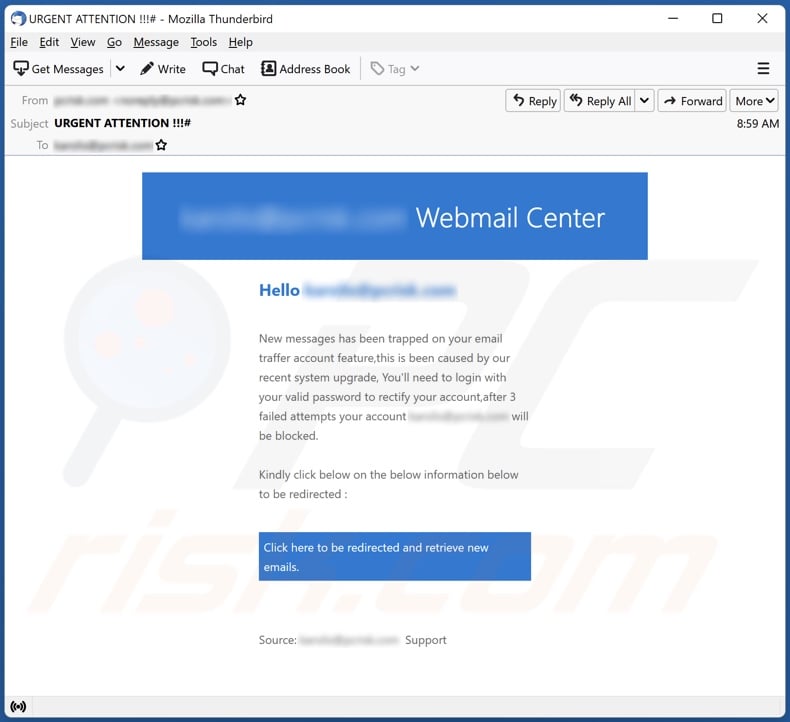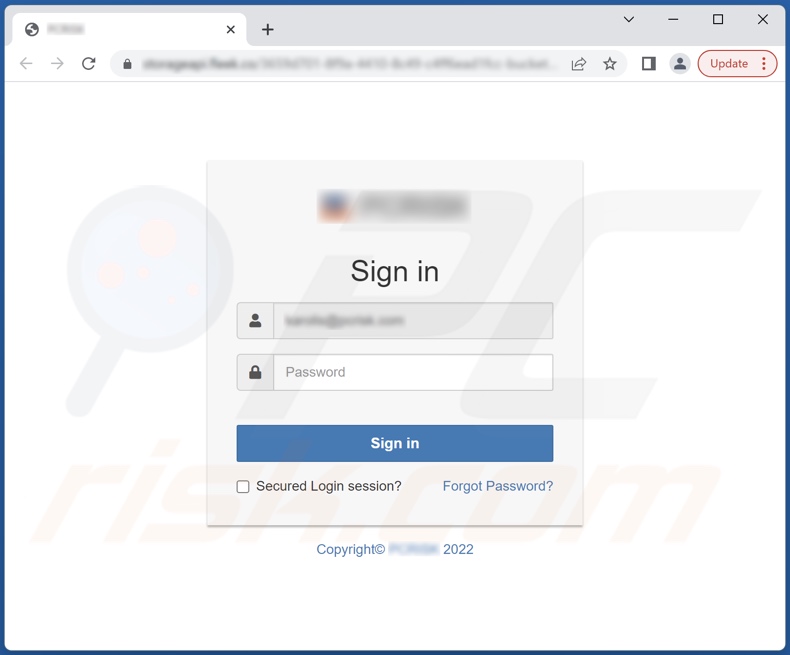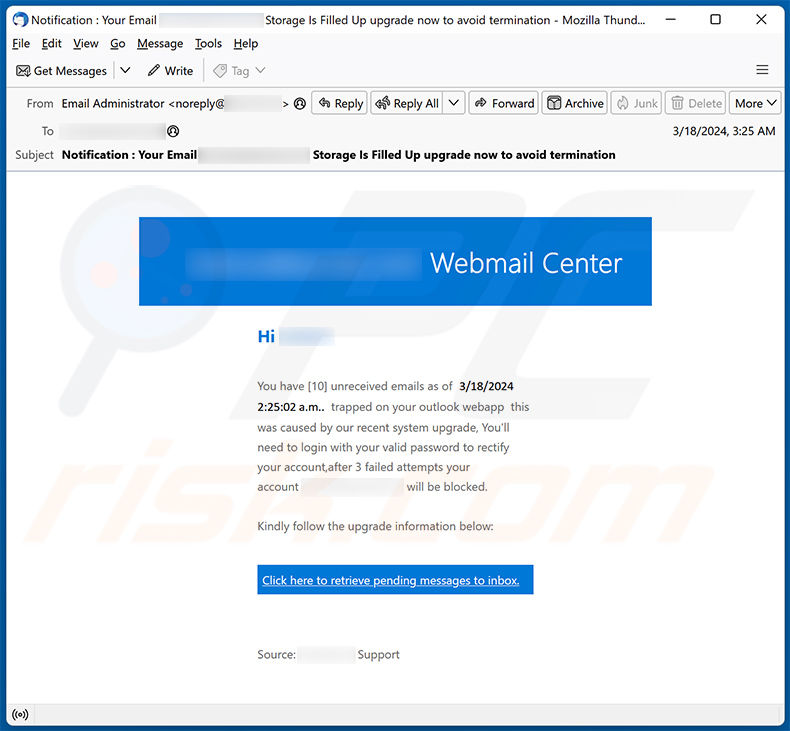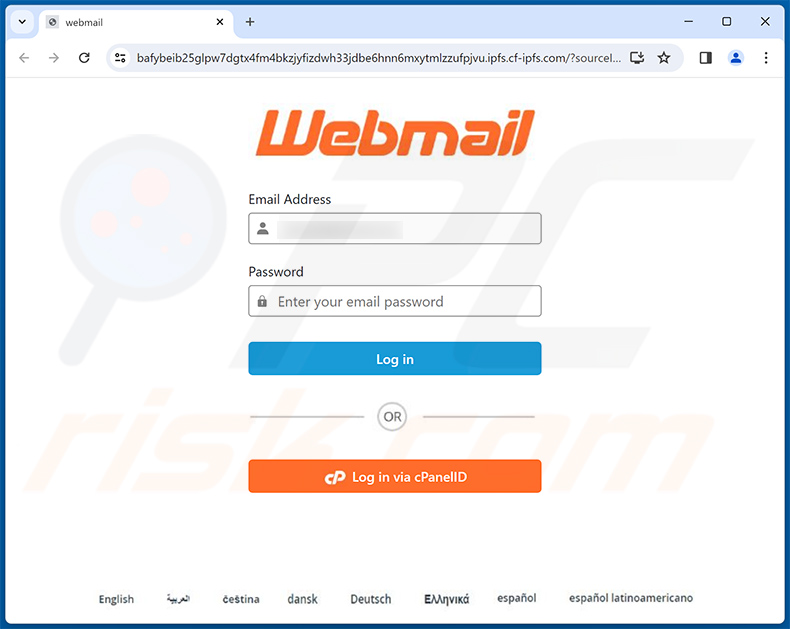Avoid having your email account stolen via fake "Webmail Center" emails
Phishing/ScamAlso Known As: Webmail Center phishing email
Get free scan and check if your device is infected.
Remove it nowTo use full-featured product, you have to purchase a license for Combo Cleaner. Seven days free trial available. Combo Cleaner is owned and operated by RCS LT, the parent company of PCRisk.com.
What kind of email is "Webmail Center"?
After inspecting this "Webmail Center" spam email, we determined that it operates as a phishing scam. The letter claims that due to a system upgrade, messages failed to reach the inbox. Hence, the recipient must verify their email account to receive the letters and prevent it from being blocked.
However, by attempting to complete the verification - users will inadvertently reveal their log-in credentials (passwords) to the scammers behind this spam campaign.

"Webmail Center" email scam overview
The email with the subject "URGENT ATTENTION !!!#" (may vary) states that new messages have failed to reach the recipient's inbox due to a recent system upgrade. Three attempts are given to re-verify the account by logging into it with a valid password. Should the recipient fail, their email will be blocked.
When we pressed the "Click here to be redirected and retrieve new emails." button, it redirected us to a phishing website, which was disguised as an email account log-in page. The passwords typed into such sites are revealed to the scammers behind them.
Cyber criminals target emails as they are typically used to register other platforms/services, meaning that through a stolen email - access/control may be gotten over the associated content.
For example, criminals can use social/communication platforms (e.g., emails, messengers, social media, etc.) to ask friends/contacts for loans or to spread malware - under the guise of the genuine owner. As for finance-related accounts (e.g., online banking, digital wallets, e-commerce, etc.) - they can be used to make unauthorized transactions or online purchases.
In summary, by trusting fake emails like "Webmail Center" - users can experience serious privacy issues, financial losses, and even identity theft.
If you have already provided your log-in credentials - immediately change the passwords of all potentially compromised accounts and contact their official support.
| Name | Webmail Center phishing email |
| Threat Type | Phishing, Scam, Social Engineering, Fraud |
| Fake Claim | Messages failed to reach the email, which needs to be verified in order to receive the letters and prevent the account from being blocked. |
| Symptoms | Unauthorized online purchases, changed online account passwords, identity theft, illegal access of the computer. |
| Distribution methods | Deceptive emails, rogue online pop-up ads, search engine poisoning techniques, misspelled domains. |
| Damage | Loss of sensitive private information, monetary loss, identity theft. |
| Malware Removal (Windows) |
To eliminate possible malware infections, scan your computer with legitimate antivirus software. Our security researchers recommend using Combo Cleaner. Download Combo CleanerTo use full-featured product, you have to purchase a license for Combo Cleaner. 7 days free trial available. Combo Cleaner is owned and operated by RCS LT, the parent company of PCRisk.com. |
Phishing spam campaign examples
We have analyzed countless spam emails; "TrustWallet email scam", "A Law Case Filed Against Your Company", "Email Storage Warning Message" are a few examples of phishing letters.
This mail is typically presented as "urgent", "important", or even as messages from legitimate companies, organizations, institutions, or other entities. In addition to various scams, spam mail is used to spread malware (e.g., trojans, ransomware, cryptominers, etc.).
How do spam campaigns infect computers?
Spam emails can contain virulent files as attachments or download links. These files can be in various formats, e.g., archives (RAR, ZIP, etc.), executables (.exe, .run, etc.), Microsoft Office and PDF documents, JavaScript, and so on.
Once an infectious file is executed, run, or otherwise opened - the infection chain is triggered. For example, Microsoft Office documents infect systems by executing malicious macro commands.
How to avoid installation of malware?
We highly recommend being vigilant with incoming mail since spam letters are widespread. We advise against opening the attachments/links present in dubious emails and messages - as that can lead to a system infection.
It is important to use Microsoft Office versions released after 2010 since they have the "Protected View" mode that prevents automatic macro execution.
However, malware is not spread exclusively via spam mail. Therefore, we also advise downloading from official/verified sources and activating/updating programs with legitimate functions/tools (illegal activation tools ["cracks"] and third-party updaters can contain malware).
We must emphasize that having a reputable anti-virus installed and kept updated is essential to device/user safety. Security software must be used to run regular system scans and to remove detected threats. If you've already opened malicious attachments, we recommend running a scan with Combo Cleaner Antivirus for Windows to automatically eliminate infiltrated malware.
Text presented in the "Webmail Center" scam email letter:
Subject: URGENT ATTENTION !!!#
********** Webmail Center
Hello **********
New messages has been trapped on your email traffer account feature,this is been caused by our recent system upgrade, You'll need to login with your valid password to rectify your account,after 3 failed attempts your account ********** will be blocked.
Kindly click below on the below information below to be redirected :
Click here to be redirected and retrieve new emails.
Source: ********** Support
Screenshot of the phishing website promoted by the "Webmail Center" spam campaign:

Another example of an email from "Webmail Center" spam campaign:

Text presented within:
Subject: Notification : Your Email ******** Storage Is Filled Up upgrade now to avoid termination
******** Webmail Center
Hi ********
You have [10] unreceived emails as of 3/18/2024 2:25:02 a.m.. trapped on your outlook webapp this was caused by our recent system upgrade, You'll need to login with your valid password to rectify your account,after 3 failed attempts your account ******** will be blocked.Kindly follow the upgrade information below:
Click here to retrieve pending messages to inbox.Source: ******** Support
Screenshot of the promoted phishing site:

Instant automatic malware removal:
Manual threat removal might be a lengthy and complicated process that requires advanced IT skills. Combo Cleaner is a professional automatic malware removal tool that is recommended to get rid of malware. Download it by clicking the button below:
DOWNLOAD Combo CleanerBy downloading any software listed on this website you agree to our Privacy Policy and Terms of Use. To use full-featured product, you have to purchase a license for Combo Cleaner. 7 days free trial available. Combo Cleaner is owned and operated by RCS LT, the parent company of PCRisk.com.
Quick menu:
- What is Webmail Center phishing email?
- Types of malicious emails.
- How to spot a malicious email?
- What to do if you fell for an email scam?
Types of malicious emails:
![]() Phishing Emails
Phishing Emails
Most commonly, cybercriminals use deceptive emails to trick Internet users into giving away their sensitive private information, for example, login information for various online services, email accounts, or online banking information.
Such attacks are called phishing. In a phishing attack, cybercriminals usually send an email message with some popular service logo (for example, Microsoft, DHL, Amazon, Netflix), create urgency (wrong shipping address, expired password, etc.), and place a link which they hope their potential victims will click on.
After clicking the link presented in such email message, victims are redirected to a fake website that looks identical or extremely similar to the original one. Victims are then asked to enter their password, credit card details, or some other information that gets stolen by cybercriminals.
![]() Emails with Malicious Attachments
Emails with Malicious Attachments
Another popular attack vector is email spam with malicious attachments that infect users' computers with malware. Malicious attachments usually carry trojans that are capable of stealing passwords, banking information, and other sensitive information.
In such attacks, cybercriminals' main goal is to trick their potential victims into opening an infected email attachment. To achieve this goal, email messages usually talk about recently received invoices, faxes, or voice messages.
If a potential victim falls for the lure and opens the attachment, their computers get infected, and cybercriminals can collect a lot of sensitive information.
While it's a more complicated method to steal personal information (spam filters and antivirus programs usually detect such attempts), if successful, cybercriminals can get a much wider array of data and can collect information for a long period of time.
![]() Sextortion Emails
Sextortion Emails
This is a type of phishing. In this case, users receive an email claiming that a cybercriminal could access the webcam of the potential victim and has a video recording of one's masturbation.
To get rid of the video, victims are asked to pay a ransom (usually using Bitcoin or another cryptocurrency). Nevertheless, all of these claims are false - users who receive such emails should ignore and delete them.
How to spot a malicious email?
While cyber criminals try to make their lure emails look trustworthy, here are some things that you should look for when trying to spot a phishing email:
- Check the sender's ("from") email address: Hover your mouse over the "from" address and check if it's legitimate. For example, if you received an email from Microsoft, be sure to check if the email address is @microsoft.com and not something suspicious like @m1crosoft.com, @microsfot.com, @account-security-noreply.com, etc.
- Check for generic greetings: If the greeting in the email is "Dear user", "Dear @youremail.com", "Dear valued customer", this should raise suspiciousness. Most commonly, companies call you by your name. Lack of this information could signal a phishing attempt.
- Check the links in the email: Hover your mouse over the link presented in the email, if the link that appears seems suspicious, don't click it. For example, if you received an email from Microsoft and the link in the email shows that it will go to firebasestorage.googleapis.com/v0... you shouldn't trust it. It's best not to click any links in the emails but to visit the company website that sent you the email in the first place.
- Don't blindly trust email attachments: Most commonly, legitimate companies will ask you to log in to their website and to view any documents there; if you received an email with an attachment, it's a good idea to scan it with an antivirus application. Infected email attachments are a common attack vector used by cybercriminals.
To minimise the risk of opening phishing and malicious emails we recommend using Combo Cleaner Antivirus for Windows.
Example of a spam email:

What to do if you fell for an email scam?
- If you clicked on a link in a phishing email and entered your password - be sure to change your password as soon as possible. Usually, cybercriminals collect stolen credentials and then sell them to other groups that use them for malicious purposes. If you change your password in a timely manner, there's a chance that criminals won't have enough time to do any damage.
- If you entered your credit card information - contact your bank as soon as possible and explain the situation. There's a good chance that you will need to cancel your compromised credit card and get a new one.
- If you see any signs of identity theft - you should immediately contact the Federal Trade Commission. This institution will collect information about your situation and create a personal recovery plan.
- If you opened a malicious attachment - your computer is probably infected, you should scan it with a reputable antivirus application. For this purpose, we recommend using Combo Cleaner Antivirus for Windows.
- Help other Internet users - report phishing emails to Anti-Phishing Working Group, FBI’s Internet Crime Complaint Center, National Fraud Information Center and U.S. Department of Justice.
Frequently Asked Questions (FAQ)
Why did I receive this email?
Cyber criminals distribute spam mail in massive operations - therefore, thousands of users receive identical messages.
I have provided my personal information when tricked by this spam email, what should I do?
If you have disclosed account credentials - change the passwords of all potentially exposed accounts and inform their official support without delay. And if you've provided other private data (e.g., ID card details, credit card numbers, etc.) - immediately contact the relevant authorities.
I have read a spam email but didn't open the attachment, is my computer infected?
No, system infection chains are only triggered when the attachments or links present in spam emails are opened/clicked.
I have downloaded and opened a file attached to a spam email, is my computer infected?
Whether the device was infected may depend on the opened file's format. If it was an executable (.exe, .run, etc.) - most likely, yes - your system has been infected. However, documents (.xls, .doc, .pdf, etc.) may require additional user interaction (e.g., enabling macro commands) to begin downloading/installing malware.
Will Combo Cleaner remove malware infections present in email attachments?
Yes, Combo Cleaner is capable of detecting and eliminating nearly all known malware infections. It is noteworthy that performing a complete system scan is crucial - since sophisticated malicious programs usually hide deep within systems.
Share:

Tomas Meskauskas
Expert security researcher, professional malware analyst
I am passionate about computer security and technology. I have an experience of over 10 years working in various companies related to computer technical issue solving and Internet security. I have been working as an author and editor for pcrisk.com since 2010. Follow me on Twitter and LinkedIn to stay informed about the latest online security threats.
PCrisk security portal is brought by a company RCS LT.
Joined forces of security researchers help educate computer users about the latest online security threats. More information about the company RCS LT.
Our malware removal guides are free. However, if you want to support us you can send us a donation.
DonatePCrisk security portal is brought by a company RCS LT.
Joined forces of security researchers help educate computer users about the latest online security threats. More information about the company RCS LT.
Our malware removal guides are free. However, if you want to support us you can send us a donation.
Donate
▼ Show Discussion